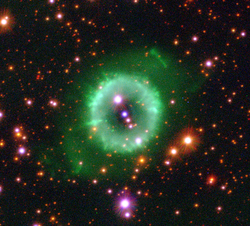Astronomy:NGC 6337
| Emission nebula | |
|---|---|
| Planetary nebula | |
 Image of NGC 6337 with the VLT Survey Telescope. Green part of the image was taken with the H-alpha filter. | |
| Observation data: J2000 epoch | |
| Right ascension | 17h 22m 15.67s[1] |
| Declination | −38° 29′ 01.73″[1] |
| Apparent magnitude (V) | 0.783' (arcmin)[1] |
| Constellation | Scorpius |
| Designations | Ghostly Cheerio, Cheerio Nebula |
NGC 6337, the Ghostly Cheerio or Cheerio Nebula, is a toroidal planetary nebula in the constellation Scorpius. It appears as a ring-shaped (annular) transparent nebula resembling a piece of the breakfast cereal Cheerios, hence the name. Filament and knots, and a faint shell surround the ring.[2] Its magnitude is 11.90; its position in Scorpius is right ascension 17h 22m15.67s, declination -38° 29' 01.73".[1] The Ghostly Cheerio has a redshift value of -0.000236.
There is convincing evidence that a binary nucleus exists at the center of the nebula,[3] with masses of 0.6 and 0.3 M⊙, and a separation of ≤ 1.26 R⊙, indicating a probable common envelope phase. The Ghostly Cheerio's projected radial expansion is slow, averaging 1–2 kilometres per second (0.6–1.2 mi/s).[2]
See also
References
- ↑ 1.0 1.1 1.2 1.3 "Simbad NGC 6337". http://simbad.cds.unistra.fr/simbad/sim-id?Ident=NGC+6337&NbIdent=1&Radius=2&Radius.unit=arcmin&submit=submit+id.
- ↑ 2.0 2.1 Ma. T. García-Díaz; D. M. Clark; J. A. Lopez; Wolfgang Steffen; Richer M. G. (July 2009). "The outflows and 3D structure of NGC 6337, a planetary nebula with a close binary nucleus". The Astrophysical Journal 699 (2): 1633–1638. doi:10.1088/0004-637X/699/2/1633. https://www.researchgate.net/publication/249230289. Retrieved August 18, 2021.
- ↑ Hillwig T.C.; Bond H.E.; Afasr M.; De Marco O. (16 June 2010). "Binary central stars of planetary nebulae discovered through photometric variability. II. Modeling the central stars of NGC 6026 and NGC 6337". The Astronomical Journal 140 (2): 319–327. doi:10.1088/0004-6256/140/2/319. Bibcode: 2010AJ....140..319H.
 |

